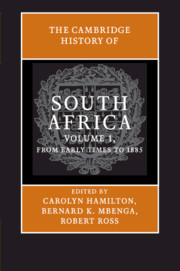Book contents
- Frontmatter
- 1 The Production of Preindustrial South African History
- 2 The Appearance of Food Production in Southern Africa 1,000 to 2,000 Years Ago
- 3 Farming Communities of the Second Millennium: Internal Frontiers, Identity, Continuity and Change
- 4 Khoesan and Immigrants: The Emergence of Colonial Society in the Cape, 1500–1800
- 5 Turbulent Times: Political Transformations in the North and East, 1760s–1830s
- 6 From Slave Economy to Settler Capitalism: The Cape Colony and Its Extensions, 1800–1854
- 7 From Colonial Hegemonies to Imperial Conquest, 1840–1880
- 8 Transformations in Consciousness
- Index
3 - Farming Communities of the Second Millennium: Internal Frontiers, Identity, Continuity and Change
Published online by Cambridge University Press: 28 September 2010
- Frontmatter
- 1 The Production of Preindustrial South African History
- 2 The Appearance of Food Production in Southern Africa 1,000 to 2,000 Years Ago
- 3 Farming Communities of the Second Millennium: Internal Frontiers, Identity, Continuity and Change
- 4 Khoesan and Immigrants: The Emergence of Colonial Society in the Cape, 1500–1800
- 5 Turbulent Times: Political Transformations in the North and East, 1760s–1830s
- 6 From Slave Economy to Settler Capitalism: The Cape Colony and Its Extensions, 1800–1854
- 7 From Colonial Hegemonies to Imperial Conquest, 1840–1880
- 8 Transformations in Consciousness
- Index
Summary
This chapter outlines a narrative for precolonial farming societies of the second millennium A.D. in South Africa and highlights several themes. The first is that this is a period when trade relations with the wider world intensified, first with Swahili based in their East African coastal entrepôts and later with the Portuguese, Dutch, and English. The outcomes of these contacts vary, but a second theme draws attention to trade as an important factor in the growth of political complexity and the rise of social hierarchies. Some of these are referred to as state level in their complexity. In reviewing this complexity, however, the essay resists an inclination to reify steeply hierarchical systems over those that contextually combined factors of trade, wealth, and contact in different ways, that, although not monumental in scale, are no less important.
Third, the second millennium is a period when the identities that emerged historically can be identified, traced, and tracked fairly securely by a combination of archaeological, oral, and written sources. It is not a period of historical anonymity. This overlaps with the last theme, which relates to method, emphasizing in particular issues relating to analogy and the unavoidable and complex relationship between ethnographic models and their ampliative role. Ethnographic models extol cultural structure and capture historical context only in the broadest of ways. This characteristic is exacerbated when used in conjunction with structuralist assumptions.
- Type
- Chapter
- Information
- The Cambridge History of South Africa , pp. 112 - 167Publisher: Cambridge University PressPrint publication year: 2009
- 6
- Cited by

